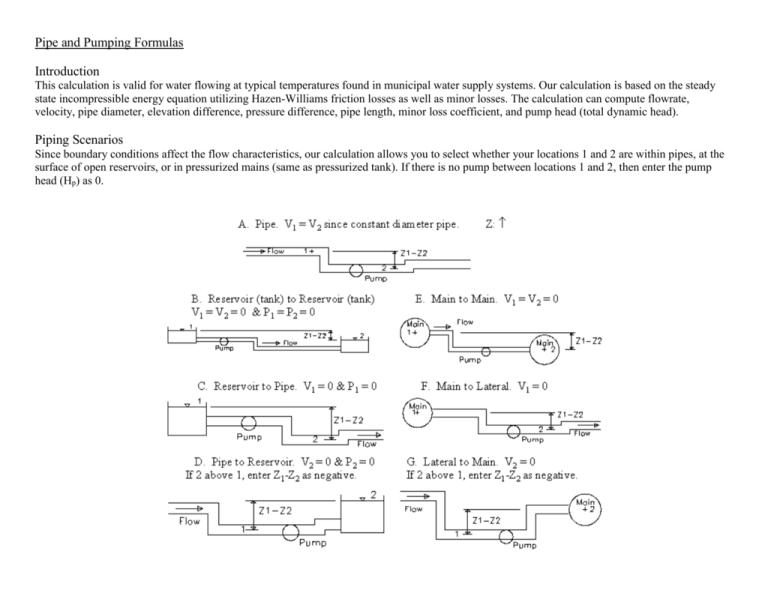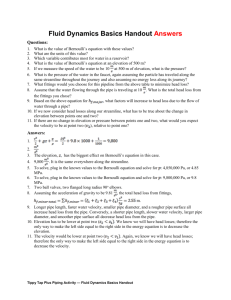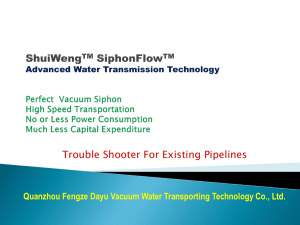Pipe-and-Pumping-For..
advertisement

Pipe and Pumping Formulas Introduction This calculation is valid for water flowing at typical temperatures found in municipal water supply systems. Our calculation is based on the steady state incompressible energy equation utilizing Hazen-Williams friction losses as well as minor losses. The calculation can compute flowrate, velocity, pipe diameter, elevation difference, pressure difference, pipe length, minor loss coefficient, and pump head (total dynamic head). Piping Scenarios Since boundary conditions affect the flow characteristics, our calculation allows you to select whether your locations 1 and 2 are within pipes, at the surface of open reservoirs, or in pressurized mains (same as pressurized tank). If there is no pump between locations 1 and 2, then enter the pump head (Hp) as 0. Steady State Energy Equation used for this page Back to Calculation The first equation shown is the steady state energy equation for incompressible flow. The left side of the equation contains what we call the driving heads. These heads include heads due to a pump (if present), elevation, pressure, and velocity. The terms on the right side are friction loss and minor losses. Friction losses are computed using the Hazen-Williams friction loss equation. The energy equation is well-accepted in the field of fluid mechanics and can be found in many references such as Cimbala and Cengel (2008), Munson et al. (1998), and Streeter et al. (1998), while the Hazen-Williams equation for friction losses is well-established in the water supply literature and can be found in references such as Viessman and Hammer (1998) and Mays (1999). The Hazen-Williams equation (the hf =... equation) is empirical and requires that you use particular units as noted below. Though the other equations are dimensionally correct, only units that can be used in all of the equations are shown below. Our calculation allows you to enter a variety of units and automatically performs the unit conversions. ft=foot, lb=pound, m=meter, N=Newton, s=second A = Pipe cross-sectional area, ft2 or m2. C = Hazen-Williams pipe roughness coefficient. See table below for values. D = Pipe diameter, ft or m. Driving Head (DH) = left side of the first equation (or right side of the equation), ft. This is not total dynamic head. g = acceleration due to gravity = 32.174 ft/s2 = 9.8066 m/s2. hf = Major (friction) losses, ft or m. hm = Minor losses, ft or m. Hp = Pump head (also known as Total Dynamic Head), ft or m. k = unit conversion factor = 1.318 for English units = 0.85 for Metric units Km = Sum of minor losses coefficients. See table below. Pump Power (computed by program) = SQHp, lb-ft/s or N-m/s. Theoretical pump power. Does not include an inefficiency term. Note that 1 horsepower = 550 ft-lb/s. P1 = Upstream pressure, lb/ft2 or N/m2. P2 = Downstream pressure, lb/ft2 or N/m2. Q = Flow rate in pipe, ft3/s or m3/s. S = Weight density of water = 62.4 lb/ft³ for English units = 9800 N/m³ for Metric units V = Velocity in pipe, ft/s or m/s. V1 = Upstream velocity, ft/s or m/s. V2 = Downstream velocity, ft/s or m/s. Z1 = Upstream elevation, ft or m. Z2 = Downstream elevation, ft or m. All of the calculations on this page have analytic (closed form) solutions except for "Solve for V, Q" and "Q known. Solve for Pipe Diameter." These two calculations required a numerical solution. Our solution utilizes a modified implementation of Newton's method that finds roots of the equations with the result accurate to 8 significant digits. All of the calculations utilize double precision. Table of Hazen-Williams Coefficients (C is unit-less) Material Asbestos Cement C 140 Material Copper C 130-140 Brass 130-140 Galvanized iron 120 Brick sewer 100 Glass 140 Lead 130-140 Plastic 140-150 Cast-Iron: New, unlined 130 10 yr. old 107-113 20 yr. old 89-100 Coal-tar enamel lined 145-150 30 yr. old 75-90 New unlined 140-150 40 yr. old 64-83 Riveted 110 Steel forms 140 Tin 130 Wooden forms 120 Vitrif. clay (good condition) 110-140 Centrifugally spun 135 Wood stave (avg. condition) 120 Steel: Concrete/Concrete-lined: Table of Minor Loss Coefficients (Km is unit-less) Back to Calculation Compiled from References Fitting Km Valves: Fitting Km Elbows: Globe, fully open 10 Regular 90°, flanged 0.3 Angle, fully open 2 Regular 90°, threaded 1.5 Gate, fully open 0.15 Long radius 90°, flanged 0.2 Gate 1/4 closed 0.26 Long radius 90°, threaded 0.7 Gate, 1/2 closed 2.1 Long radius 45°, threaded 0.2 Gate, 3/4 closed 17 Regular 45°, threaded 0.4 Swing check, forward flow 2 Swing check, backward flow infinity 180° return bends: Tees: Line flow, flanged 0.2 Line flow, threaded 0.9 Flanged 0.2 Branch flow, flanged 1.0 Threaded 1.5 Branch flow, threaded 2.0 Pipe Entrance (Reservoir to Pipe): Pipe Exit (Pipe to Reservoir) Square Connection 0.5 Square Connection 1.0 Rounded Connection 0.2 Rounded Connection 1.0 Re-entrant (pipe juts into tank) 1.0 Re-entrant (pipe juts into tank) 1.0 Common Questions Back to Calculation I took fluid mechanics a long long time ago. What is head? Why does it have units of length? Head is energy per unit weight of fluid (i.e. Force x Length/Weight = Length).The program on this page solves the energy equation (shown below); we call energy "head." Why is Pressure=0 for a reservoir? A reservoir is open to the atmosphere, so its gage pressure is zero. Why is Velocity=0 for a reservoir? This is a common assumption in fluid mechanics and is based on the fact that a reservoir has a large surface area. Therefore, the water level drops very little even if a lot of water flows out of the reservoir. A reservoir may physically be a lake or a large diameter tank. What is a "main" and a "lateral"? A "main" is a large diameter water supply pipe that has many smaller diameter "laterals" branching off of it to supply water to individual residences, businesses, or sub-divisions. In fluid mechanics, we set V=0 for the main since it has a large diameter (relative to the lateral) and thus a very small velocity. To further justify the V=0 assumption, the main's pressure is typically high, so the velocity head in the main is negligible. The main is drawn such that it is coming out of your computer monitor. Can I model flow between two reservoirs using either Scenario B or E? Yes, you can. If using Scenario E, just set P1-P2=0. Scenario B automatically sets P1-P2=0. Can I model flow between two mains using either Scenario B or E? Only if the pressure is the same in both mains. How do I model a pipe discharging freely to the atmosphere? Use Scenario A, C, or F. Since P2=0 (relative to atmospheric pressure), P1-P2 that is input or output will be P1. What are minor losses? Minor losses are head (energy) losses due to valves, pipe bends, pipe entrances (for water flowing from a tank to a pipe), and pipe exits (water flowing from a pipe to a tank), as opposed to a major loss which is due to the friction of water flowing through a length of pipe. Minor loss coefficients (Km) are tabulated below. For our program, all of the pipes have the same diameter, so you can add up all your minor loss coefficients and enter the sum in the Minor Loss Coefficient input box. I'm confused about pumps. Only input Pump Head if the pump is between points 1 and 2. Otherwise, enter 0 for Pump Head. Your program is great! What are its limitations? Pipes must all have the same diameter. Pump curves cannot be implemented. The fluid must be water. Where can I find additional information? References What is Driving Head? See above definitions of variables. It is not total dynamic head. Hp is pump head (also known as total dynamic head).







